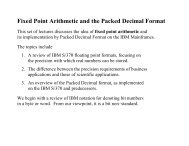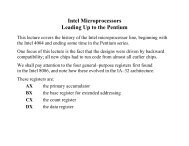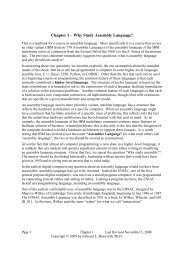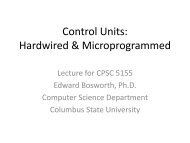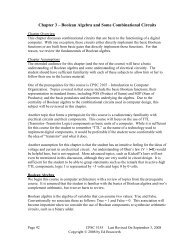Microprogramming: History and Evolution - Edwardbosworth.com
Microprogramming: History and Evolution - Edwardbosworth.com
Microprogramming: History and Evolution - Edwardbosworth.com
You also want an ePaper? Increase the reach of your titles
YUMPU automatically turns print PDFs into web optimized ePapers that Google loves.
<strong>Microprogramming</strong> is Taken Seriously<br />
(By IBM’s Customers)<br />
The primary intent of the IBM design team was to generate an entire family of <strong>com</strong>puters<br />
with one ISA (Instruction Set Architecture) but many different organizations.<br />
<strong>Microprogramming</strong> allowed <strong>com</strong>puters of a wide range of <strong>com</strong>puting power (<strong>and</strong> cost)<br />
to implement the same instruction set <strong>and</strong> run the same assembly language software.<br />
Several of the IBM product line managers saw another use for microprogramming, one<br />
that their customer base thought to be extremely important: allowing assembly language<br />
programs from earlier models (IBM 1401, IBM 7040, IBM 7094) to run unchanged<br />
on any model of the System/360 series.<br />
As one later author put it, it was only the introduction of microprogramming <strong>and</strong> the<br />
emulation of earlier machines allowed by this feature that prevented ―mass defections‖ of<br />
the IBM customer base to other <strong>com</strong>panies, such as Honeywell, that were certainly<br />
looking for the business.<br />
This idea was proposed <strong>and</strong> named “emulation” by Stewart Tucker (quoted above).



